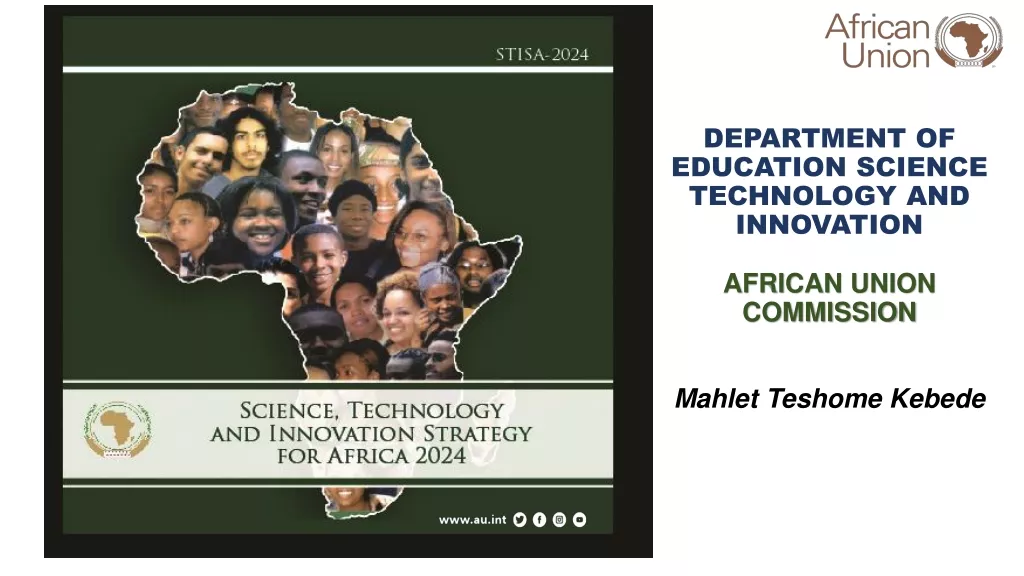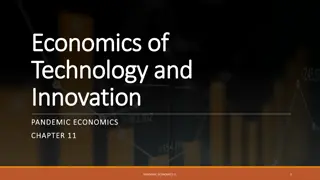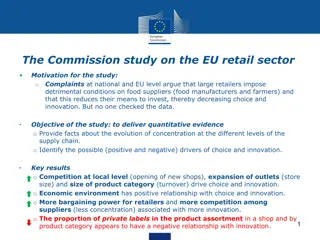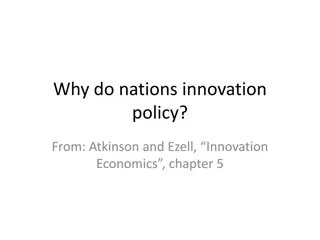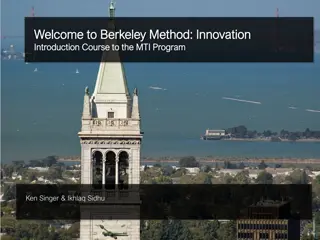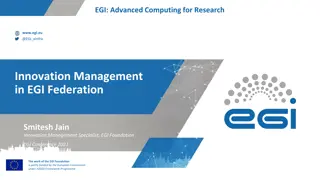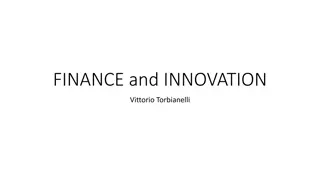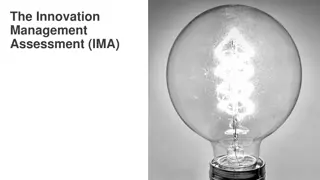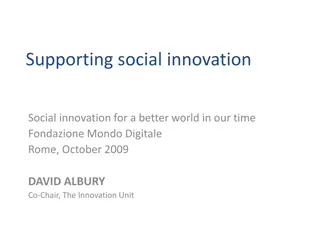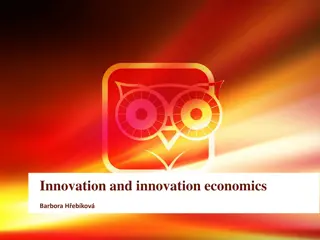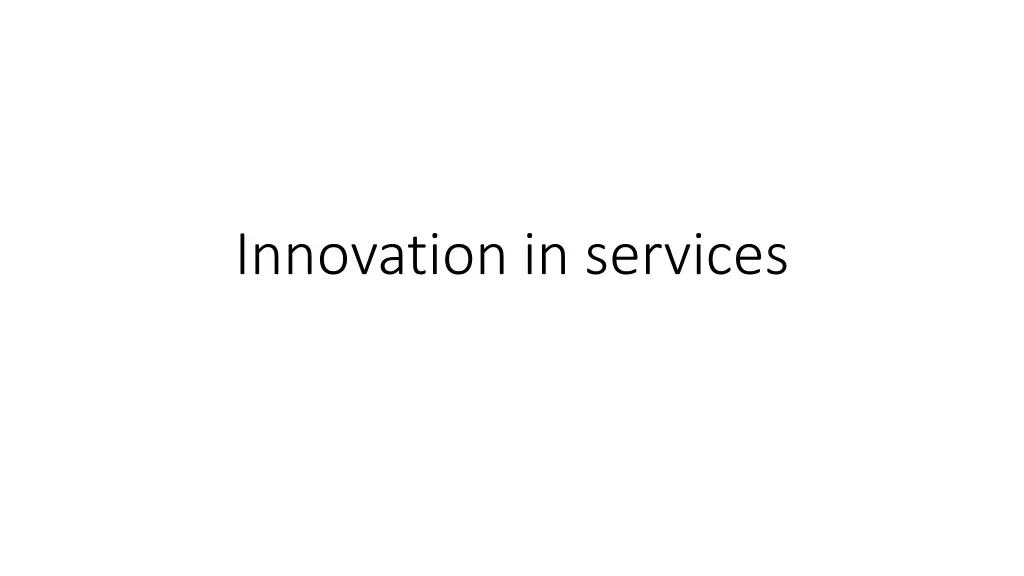
Innovation in Services: Importance and Impact Beyond Economics
Discover the significance of innovation in the vast services sector, extending beyond economic benefits. Explore how services influence various industries, from technology-intensive sectors to social services, and understand the diverse nature of services in modern economies.
Download Presentation

Please find below an Image/Link to download the presentation.
The content on the website is provided AS IS for your information and personal use only. It may not be sold, licensed, or shared on other websites without obtaining consent from the author. If you encounter any issues during the download, it is possible that the publisher has removed the file from their server.
You are allowed to download the files provided on this website for personal or commercial use, subject to the condition that they are used lawfully. All files are the property of their respective owners.
The content on the website is provided AS IS for your information and personal use only. It may not be sold, licensed, or shared on other websites without obtaining consent from the author.
E N D
Presentation Transcript
A topic of growing interest Services: are the larger part of employment and output (Value Added) in most industrial countries. (EU around 70%) The services sectors are important for countries productivity, economic competitiveness, and quality of life . ..but innovation in services is important for other reasons beyond the economic importance of the service sector : 1) It extends beyond the services sectors to affect service activities in all sectors of the economy. 2) some services play central roles in innovation processes throughout the economy, as agents of transfer, innovation support, and sources of innovations for other sectors.
A wide and varied sector Contrasts in the composition of the services sector in different countries; Huge range of different activities with very different characteristics: From hairdressing (small scale base) to FIRE (finance, insurance, and real estate services), dominated by very large firms Key sectors use advanced information technologies intensively, but other technologies are used in distributive services, which include transport in all its varieties Social and collective services such as public administration and health and educational services are delivered largely or entirely through the state but the back-office operations of such bodies can be highly IT-intensive.
wide and varied sector (2/2) Technical skills range from the minimal ones used in fast food outlets and office cleaning to the professional qualifications of market researchers and architects, and the scientific and engineering credentials of staff in specialized R&D firms. Any generalizations about the nature of services and innovation in services must be qualified by numerous exceptions. Some services are more like manufacturing in terms of some parameters some are technology-intensive (e.g. media, telecommunications) some work with material artifacts (e.g. rapid prototyping, repairs). And the operations of many manufacturing firms include a great many services activities (e.g. transport and logistics, office work, marketing and aftersales). Nevertheless, a set of common features characterizes many services and differentiates them from manufacturing
Wide spectrum of tranformations Services markets also are diverse, spanning consumers, businesses, and the public sector and its clients. The transformations effected by these services industries operate on such diverse raw materials as: human clients (as well as some other biological organisms, e.g. veterinary services), physical artifacts (they may be repaired, maintained, stored, transported, tested, integrated into larger systems . . . ), and data, symbols and information (that may be processed, stored, telecommunicated, etc. by services like financial industries as well as by computer and communications services, etc.).
Interactivity and information Services are typically interactive high levels of contact between service supplier and client Service products are often produced and consumed in the course of supplier client interaction at a particular time and place coterminality ; Innovations may focus on this interaction as much as on conventional product and process characteristics, and may rely less on technical knowledge and more on social and cultural nous. ** Many services are highly information-intensive, with a preponderance of office-based work or communicative and transactional operations The informational components of many other services are subject to IT-based innovation.
Reserach on innovation in services: the R&D issue Research on innovation in services received little systematic attention until the 1980s; in the 1990s, a number of major research projects on were launched, starting from the R&D aspect. Many surveys revealed growth in R&D investment within services: R&D performance by the U.S. service-sector industries underwent explosive growth between 1987 and 1991 (e.g. computer industry; but R&D on a contract basis) R&D within the EU s service sector has doubled since the mid-1980s, accounting for about 11 per cent of total industrial R&D by 1997. R&D surveys may still underrepresent the innovative activities of service firms. (a) increased coverage of services firms by R&D surveys (b) reclassification of some large firms activities into the services sector.
Key characteristics of service innovation This picture of service-sector R&D investment undermines the traditional view that innovation in services results solely from the sector s adoption of manufacturing innovations. Services firms are major innovators, and that it is not just high-tech services (like software and telecommunications) which play significant roles in technology development. Although there are innovative activities in all branches of services, the innovation surveys depict lower levels of innovation and R&D investment within services, on average, than within manufacturing. The adoption by services firms of technologies produced in other sectors is a major form of innovation in the sector, much of which thus displays supplier-driven characteristics.
Standardization and customization Such patterns of innovation may be related to the ways in which (most) services differ from (most) manufacturing firms. Services interactivity means that their products are often customized to particular client needs. Historically this characteristic has entailed the provision of services on a small scale and local basis. In fact many services have been highly standardized and technology-intensive for a long time = industrialization of service sector (Levitt) but McDonald s and other fast food restaurants are one familiar example of standard/customized approach: they display a measure of customization, in that their products are composed of various components, or modules. The industrialization of services has been criticized as generating low-quality, low-skill jobs or social exclusion (call centers; hypermarkets vs street shopping)
Manifacturing / services: vs the quality control After all, many manufacturing firms now emphasize flexible specialization, mass customization, reintegration of highly atomized division of labor: Some of these trends are making manufacturing more like services and some are being emulated by large services companies, even as other service organizations continue to follow more classical industrialization trajectories Services have emulated manufacturing is in the adoption and development of an organizational innovation: quality control procedures. It requires firms to view their services as consisting of a number of component parts to which quality control principles can be applied and engineered . Information Technology is often introduced in the context of improving customer service quality but these components can be transformed or reconfigured into new service bundles
Key drivers 1) Modularization underpins much services innovation, since decomposition of service processes and/or products may spur process innovation and the identification of new products and product combinations. provision of customized services through recombinations of standard service modules. This type of innovative activity does not necessarily rely on R&D investment 2) Another major impetus to services industrialization has been the application of I.T. e.g. Enterprise Resource Planning software and systems back-office automation through IT also has changed the spatial location of service activities (e.g. off-shoring; call centers).
FOCUS: Services Diversity and IT-related Innovation Trajectories
Services: the kingdom of IT applications IT has been very widely applied across service sectors disproportionately more investment in IT from services than from manufacturing; In some cases, little more than adopting mobile telephones, personal computers, and similar devices and their supporting software and services. In many cases, Large service users in sectors like finance and retail have invested huge sums in developing sophisticated networks and new systems for capturing, archiving and analyzing data. IT as general purpose technology for information-processing activities of services..
IT: not the only technology IT is by no means the only technology employed in services Medical services and specialized biotechnology service firms are major users of genomics and post-genomics knowledge and techniques
Differences with manufacturing: Reverse PC IT-based services innovation has followed a pattern that differs from that usually depicted for manufacturing. Services innovation or more precisely, their IT-based innovation typically follows a Reverse Product Cycle (RPC). RPC involved three phases: 1. 2. 3. Improved Efficiency, Improved Quality, and New Services. IT was first introduced to improve existing processes, and only later became the basis for service product innovation, reversing the product cycle model of manufacturing innovation (1. product .3. process)
Ways to apply IT to service innovation Example: Insurance services moved from computerization of policy records, to providing online policy quotations, and then to supplying complete online services during these three decades. Many new telematics service firms such as EDS, which emerged from General Motors were organized around manufacturing firms in-house innovations in communications and data management processes;
RPC? Critics of the RPC model have highlighted a number of issues: counterexamples (e.g. in IT-based services, which often begin with product innovations); the blurring of production and consumption makes it difficult to establish a point in time at which innovation shifts from efficiency enhancement to product innovation The interrelation of market competition, firm circumstances and innovation dynamics: the RPC story of innovation processes was rarely applicable. At best it was one of a number of possible patterns of development. The RPC approach, may neglect non-IT innovations and innovations undertaken in earlier periods of service innovation (but starting point for further research on services innovation).
Focus on interactivity (1/2) Other studies; more emphasis on the relation between service frms and their clients. servuction (services production, intended to highlight analogies with manufacturing production activities remember the paragraph on LMT! ). interactivity : producing and sustaining supplier client relations and delivering service. Relations framework: distinction between: jobbing relations (where the service supplier provides a relatively standardized service), and sparring ones (where the supplier and client negotiate the details of what service is to be provided, and how).
interactivity (2/2) The more interactive services: greater exchange of knowledge between service firm and client, the learning processes involved can be a fertile basis for innovation: The RPC approach argues (???) that IT-based innovation begins with back-office processes and then moves forward into functions involving more customer contact and new service-products For some sectors is possible (banking sector!). Scope for innovation in other customer-facing functions, for example in targeted marketing and in computer-assisted helplines. IT-based innovation may apply to the informational elements of such service provision marketing, ordering, transactions, etc.
Differences in transfromations 1) Physical Services Another approach to examining the way in which services differ considers the key transformations that they effect, and distinguishes among three broad groups of services (Miles 1993). *** 1) Physical Services (transport, domestic services, catering etc.) involve physical transformations. particularly suitable for the application of automotive and electric power technologies e.g.; competition among modes of provision (e.g.: transport mode; laundry/launderette, etc.) the competition between modes of provision can go much deeper. In particular, consumer services such as laundry or food preparation have been subject to competition from self-services, production by consumers in the household. IT: New linked innovative services (e.g.: transport informatics )
2) The Human Services sector 2) The large-scale Human Services subsector Organized under the auspices of the welfare state: many of the front-office tasks in this subsector have had little scope for application of generic IT. Many of the Social Welfare activities of this subsector have utilized office and communications systems The Medical field has exploited successive generations of medical technology equipment
2) The human service sector (2) This sector combines: large-scale administrative data processing applications (payroll, pensions, passports, driving licenses, and the like) and planning (for example, managing housing systems and waste disposal services, monitoring epidemiological and environmental statistics); tasks that are much more customized in terms of the characteristics of specific citizens or clients. The large-scale tasks were early pioneers of computer use. Now, PCs and data networks are being widely adopted decision support in the context of the details of individual clients Self service provision: public access terminals or home-based equipment to gather information on service provision
3) Information Services 3) Information Services are relatively less dependent on motor power technologies, although electricity is important to them. Use of information technologies (IT), including those that predate new IT and its foundations in microelectronics. Some of these services, such as broadcasting and cinema, are founded on these technologies. Others, like consultancies and technical services, and financial services, have used them as important tools for producing and delivering their outputs.
Understanding Dynamics This sort of analysis provides a useful mapping of different types of services and innovation trajectories, but reveals little about the dynamics and processes of innovation in the various services that have been distinguished. **
Difficult links with innovation systems Their increased technology-intensity of service sector has not yet transformed all of the features of innovation in services! The low technology-intensity that previously characterized services meant that many services firms paid little attention to strategies for the management or adoption of innovation. Most service firms would have little incentive to be linked into innovation systems that would connect them with those responsible for generating the new technologies. in the wider innovation systems themselves, few of the innovation- related facilities offered by institutions such as university departments, research institutes, and government laboratories are tailored to the requirements of services
Approach to innovation on ad-hoc basis Many service firms are unable to apply relevant knowledge, and, more particularly, are unable to learn effectively. They can rapidly adopt on the shelf technologies like PCs, but find it harder to develop more customized or innovative solutions. services innovation is rarely organized in terms of the standard models of R&D management structures, and is typically conducted on a more ad-hoc, project management basis.
some exceptions Have their laboratories to develop technologies: 1. Rail, broadcasting, and telecommunications services, many of which were state-owned; 2. and very large organizations for much of their existence, were closely related to manufacturers (e.g. . 3. Supermarket chains have become adept managers of their own supply chains, and are often active in dictating production processes and products, including innovations in their agricultural and manufacturing suppliers. 4. Business services: consultancies, training organizations, firms helping to service new technologies are just a few of the agents involved here not to mention specialized R&D and design services themselves!
Focusing on Business Services and KIBS BS have also become highly evident contributors to innovation across the economy; they provide intermediate inputs to industry and other organizations Knowledge-intensive business services (KIBS), in particular, play important roles in innovation systems Some are transnational firms, dealing with knowledge from the frontier of practice. But many are smaller: locally based KIBS may be important agents of transfer of locally-specific knowledge, embedded in local networks (e.,, universities), between actors in regional innovation systems: KIBS include all kinds of business services that are founded upon highly specialized knowledge social and institutional knowledge in many of the traditional professional services, or more technological and technical knowledge. Others are directly based on scientific and technological knowledge testing, prototyping, environmental services, engineering consultancy,
KIBS innovatin role Technology-related KIBS sectors are among the most active innovators in the economy: what are these innovator roles? KIBS may provide the firm with general information about its internal operations and external environments. Technology and innovation related information often forms part of this. KIBS may simply play a role in identifying the nature of a particular problem or class of problems confronting the firm (for instance, that competitors are launching products with new functionalities, that regulations may mean that processes will have to generate less of a particular pollutant, etc.). KIBS may propose ways of solving a technological problem (for example recommending that particular strategies are undertaken for product or process innovation). They may provide advice (for example, recommending a specific technological solution), or actually implement such a solution on a turnkey or long-term basis (as in the case of systems integrators and facilities managers.
Innovation Policies often neglect the potential innovator and system integrator ole played bi KIBS. One exception is Finland, where KIBS are being treated as important actors in the innovation process. We have seen that KIBS are signifcant elements of innovation systems, and as policy adopts a more systemic viewpoint, we can expect their role to become more of a focus in policy.
Specific approache to management of the innovation process Not R&D based innovation due to the legacy but it also partly reflects the fact that the features of different types of economic activity can shape innovation processes and trajectories in distinctive ways. Arguably, the nature of service innovations demands different approaches to management and organization of the innovation process e.g. more emphasis on the service workers (especially if professionals) and clients, and on the interaction process between them. The traditional R&D lab may not be well suited to such innovations But these generalizations need to be qualified to take into account the enormous heterogeneity within services




